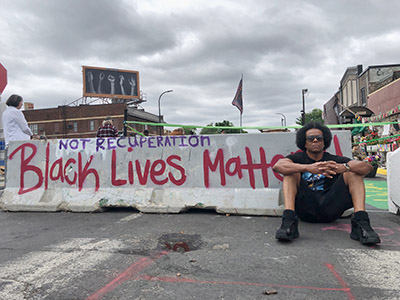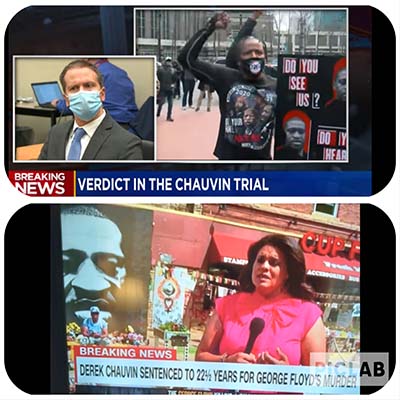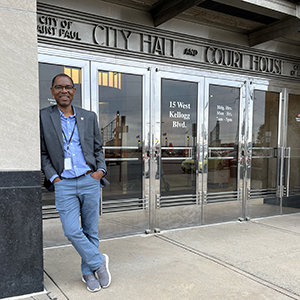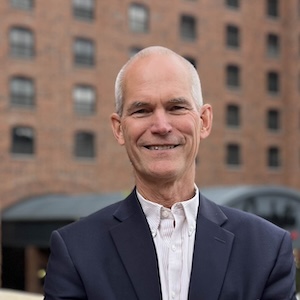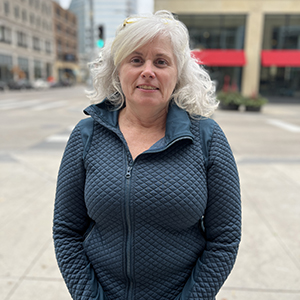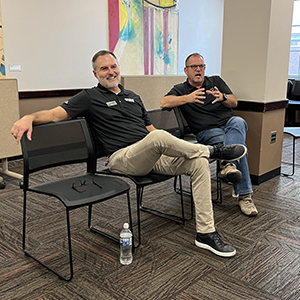Construction Management student Willie Austin became an activist for police reform when he learned he had more than one thing in common with George Floyd
On May 25, 2020, a Black man bought cigarettes at a South Minneapolis neighborhood convenience store with a twenty-dollar bill. The store clerk suspected that the bill was counterfeit and called the cops. Within an hour, the man whose name would soon be chanted by millions around the world, was choked to death under the knee of the arresting officer. The entire incident was filmed by a teenager on her cell phone while the crowd of bystanders begged the officer to let the man live.
That day, George Floyd’s name was added to the growing list of unarmed and often innocent Black people killed at the hands of police. As outrageous as it was, the incident was nothing new or surprising to African Americans, who say they live under the menace of police brutality every day. What's new is the pervasiveness of videos and photos captured on mobile phones by witnesses to the crimes. White Americans were seeing the evidence with their own eyes and waking up to the issue of systemic racism in policing.
Thousands of white people joined their Black and brown neighbors in the streets of Minneapolis to call for the arrest of the officers involved. Within days, there were people in the streets shouting “I can’t breathe” and “justice for George Floyd” in every major city in the United States, marking the largest protests in US history.
Among them was Willie Austin, a 22-year member of a local labor union, halfway through his Construction Management degree at the University of Minnesota College of Continuing and Professional Studies. Austin, who has family ties to the neighborhood around 38th and Chicago, says the murder opened up an old wound.
Healing Old Wounds
George Floyd was killed
“What I saw happen to Mr. Floyd actually provided me the courage to talk about my own trauma at the hands of the Minneapolis Police Department,” says Austin, who began speaking out for police reform. “From the age of 19 to 53, I carried those burdens with me and I never healed, even though I continued to move forward with my life. So when I saw what happened to George Floyd, it just woke me in a way that I no longer felt shame for my own run-ins with the police. And that actually helped me to heal and be whole again.”
Violence at the hands of police wasn’t the only thing Austin shared with Floyd. Austin was once accused of trying to deposit a counterfeit bill at a bank. In his case, however, he was able to prove that the bill in question came from another bank because, having worked as a teller, he knew there would be a video recording of the transaction. “Long story short, the cops arrived on the scene. They heard the conversation that I was having between the two banks, and I wasn't arrested and I walked away from that. But George Floyd didn't walk away from a similar encounter. If it wasn't for my bank experience and my ability to articulate what happened, who knows?”
Austin says the similarities he had in common with Floyd cemented his activism. “I just knew that I couldn't afford to sit silent and bear that burden on my own any longer. So I became really active. I was at George Floyd Square a lot. I spent a lot of time in that neighborhood as a youth growing up and as a young man. My barber was next door to Cup Foods before I let my hair grow out—I've got a pretty good-sized afro now. I had a lot invested in that community and when I saw what happened to him it just woke me.”
Finding Common Ground
Austin attended many of the rallies around the Twin Cities and went to the March on Washington, finding common ground among the people he met. “My activism was centered around sharing my story with others. I wasn't necessarily standing on a podium with a microphone in my face, preaching. When I was in DC, I talked to regular, everyday people who felt moved by what they saw and felt they had to do something to change. I was in Lafayette Square, where the community was out milling around, double-dutch jump roping, playing music through their Bluetooth speakers.
TV news coverage of the guilty verdict
“I met this white family from Nebraska, they were in front of the Lincoln Memorial. Their daughter was like 16. We started talking and it turned out that me and that young lady shared the same birthday! I met a white married couple who had scribbled on their T-shirts, ‘white silence equals white complicity’ or something to that effect. We were sitting on the ground and started talking about what brought us to DC. The husband and I were the same age, and he was telling me about a traffic stop where he was speeding and he knew he was going to jail. The cop, who was also white, patted him on the back and told him, ‘Just be careful next time.’ He said that was his a-ha moment when he realized just how different policing was based on race in this country. It moved him to a place where his eyes were opened.”
Austin was outside the downtown Minneapolis courthouse on the day the verdict of the officer who killed Floyd was due to be announced. Having become known as an outspoken voice among protesters by both local and national correspondents, he was asked for comment. Jelani Cobb, a race and policy writer for the The New Yorker, wrote in his Letter from Minneapolis about the activities surrounding the trial: “A fifty-four-year-old man named Willie Austin told me that he was trying not to get his hopes up. ‘I mean, it can get ugly either way it goes.’” After the officer was found guilty, the Pioneer Press quoted Austin saying, “I prayed for this. It’s an unbelievable feeling for us to win one. We’ve been losing so many.”
Like it did for a lot of people, being among thousands of citizens of all stripes during the uprising in the wake of George Floyd’s murder inspired Austin and gave him hope for the future. “All those people who came out to protest in support of the trauma that Black people face every day, that was empowering in and of itself.”
Willie Austin is a student in the Construction Management Bachelor’s Degree program, where he’s studying to become a project manager; he plans to graduate in spring 2023. Austin is also a recipient of the CCAPS Osher Reentry Scholarship.

